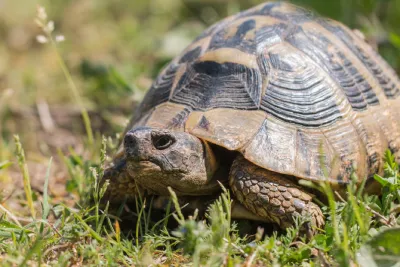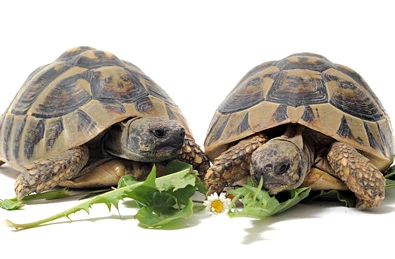These notes will apply only to the Mediterranean tortoises – Spur-thighed tortoise and Herman’s tortoise (Testudo graeca and Testudo hermanii).
The aim is to get your tortoise to thrive not merely survive from year to year.
Learn more about our Exotic pets services
Heat: How to keep your tortoise warm

The most important aspect of husbandry to consider is heat. Everything to do with tortoises requires heat to function properly – demeanour, appetite, digestion, locomotion and healing processes. Tortoises are cold-blooded and, therefore, require an external heat source to raise their body temperature to an acceptable level. A tortoise’s preferred temperature is about 30˚C. This can only be achieved with bright sunlight or a basking lamp. A dull day or the background temperature of a house does not provide adequate warmth. A tortoise should feel noticeably warm to the touch when handled.
It is therefore essential to provide a tortoise with a basking lamp for the spring and autumn when it is unlikely to warm enough outside and also for dull or wet days during the summer. The use of basking lamps will considerably extend the tortoise’s active period and reduces the length of hibernation. This will enable them to eat much better and achieve a good body weight in preparation for hibernation. Use of basking lamps in the spring is especially important to get the tortoise active and eating well again, as quickly as possible, after hibernation. A tortoise must be eating within a few days of emerging from hibernation and if not, advice should be sought from a vet with an interest in tortoises. It is not usually warm enough or for long enough for a tortoise to go outside until late May, depending on the weather.
A basking lamp can be quite simple to provide using a length of electric cable with a lamp fitting and suspending the lamp from a bracket or from ceiling. The bulb should be at about 6 inches/ 15cm from the top of the tortoise’s shell. Various specific equipment can be bought from reptile stores. Small tortoises can be managed in a tortoise table but larger mature tortoises need more space and an indoor penned area will need to be created with a lamp provided. Smaller tortoises will need a 60w bulb but larger tortoises will require a 100w bulb. It is preferable to buy a proper reptile basking bulb, which also emits UV light. The bulb must be a spot-light style of bulb to project the heat and light downwards. The light should be on for 12-14 hours a day. No heat is required overnight, unless there is any risk of the temperature dropping below 5˚C. Several lamps will need to be provided for a group of tortoises
Provision of a basking lamp improves enormously the quality of life for the tortoise. They will be so much happier and healthier for it.
Learn more about our Exotic pets services
What to feed your pet tortoise
Tortoise are vegetarian and should not be fed any meat or dairy products. They should not be fed any processed human foods- for example - bread, jam, pasta etc.
The tortoise should be provided water, although they will get most of their water from the food. It is more critical in a vivarium or tortoise tables where the environment can be hotter and drier.
Tortoises can be fed a great variety of green foods. The most important factor is variety. The greater the variety of foods the more likely it is that the tortoise will receive the full range of nutrients, vitamins and minerals that they require.
It is not, however, easy or indeed possible to provide these throughout the season from March to November. It is therefore, necessary to offer a range of leafy green foods and almost anything can be used , Tortoise are naturally grazers and as you will have noticed they will eat and bite at all sorts of plants around the garden, which are not on anyone’s approved list of tortoise foods, without any untoward effects. One should not get too anxious about what to feed. All the food should be chopped finely and mixed together to encourage the consumption of a wide range of foods. This also makes the addition of calcium and vitamin powders much easier, without reducing the palatability. It is important not to allow a tortoise to become addicted to one or to a very limited range of foods as this will lead to health problems. If a tortoise is warm enough, they will generally be much less fussy.
A few general comments about what to feed:
- Do not use citrus fruits, bananas, peas or beans.
- A basic varying mixture can be created of the following items, none of would be good by themselves but are OK as part of a mixed diet: Spring greens, kale, different types of lettuce, cucumber, tomatoes, spinach, grated carrot, sliced courgettes, small amounts of apple and other soft fruits. Tortoises can appreciate variety and offering an occasional treat of something like strawberries is fine.
- It is, as mentioned earlier, the ideal to provide the garden weeds as often as possible, dandelions are a particular favourite of most tortoises, both leaves and flowers, and their deep roots, pull extra nutrients out of the soil. This is especially useful if you live in an area with calcium rich soils. All tortoise owners should encourage the growth of dandelions in a part of their garden. It is useful to add gardener’s lime to the soil to increase the calcium content of the leaves.
- Calcium supplements are very important, especially in young tortoises, where a deficiency can lead to abnormal shell growth. The calcium needs to be provided along with a vitamin D in the form of a powdered supplement. A good balance is to use calcium carbonate 4-5 days a week and a general vitamin/mineral supplement 2-3 days a week (eg Nutrobol or Vionate).
Learn more about our Exotic pets services
Tortoise hibernation advice
All tortoises should have a period of hibernation, unless they are very young and small hatchlings. Any tortoise over about 10-12 cm in length can be hibernated. However, it is important to remember that in the wild tortoises may only hibernate for 6-8 weeks, not the 5-6 months duration that tortoises have traditionally been hibernated in this country. It is important to keep hibernation time to a minimum and this is where having basking lamps available is so useful as the tortoise will be able to have a much longer active period during which they can feed well. Short periods of hibernation must span either side of the shortest day (December 22nd). A mature tortoise can be in hibernation between November and March.
Tortoise should not be fed for at least three weeks prior to hibernation. They must be kept warm during this time to encourage digestion of their food and to pass faeces. Warm water baths should be offered.
No tortoise should still be in hibernation after 1st of April.
The ideal temperature for hibernation is 5˚C. Anything below 3˚C risks frost damage and a temperature above 10˚C will not allow proper hibernation and the tortoise will start to wake up.
It can be challenging to find a good method for hibernation but the following three methods can work well.
- Fridge hibernation. This sounds alarming but can be a very effective method. A small larder fridge can be obtained cheaply, often sold as ‘drink’ fridges. Models with a glass door should be avoided. The fridge should be adjusted to set the temperature to about 5˚C, using a max/min gardeners’ thermometer. Once the tortoise is asleep it can be transferred into the fridge in a small shoe box with a small amount of bedding material. The fridge door should be opened once a day for a few seconds to allow circulation of air. If one has to leave the tortoise unattended in the fridge a small 1cm section of the rubber seal can be removed using a sharp knife and this will allow oxygen to circulate. This is a very good method of hibernation and is not dependent of weather conditions and a warm spell in February will not cause the tortoise to wake up. The tortoise can then be woken up at a convenient time. One note of caution – a fridge can only lower the temperature in relation to the surrounding temperature, so the fridge should not be placed anywhere where the surrounding temperature will fall below 5˚C.
- Outside hibernation. This is a natural method, as it allows the tortoise to regulate its own temperature, but not entirely free of risk. Many tortoises have successfully hibernated outside but there are a few basic requirements: there needs to be dry light soil available - under bushes and trees to enable the tortoise to dig themselves in deeply enough. They should not get too wet from rain during hibernation and there should be no risk of rodent or fox attack damage. Rat attacks can cause catastrophic damage to hibernating tortoises. A way of combining the advantages and minimising the risks is to use a half depth dustbin filled with peat and sand mixture and buried into the ground with just the top edge protruding so the laid can be placed. The tortoise can be placed in the Bin and allowed to dig itself in. This can be a very effective method.
- ‘Box in the Garage Method’, which is the least satisfactory method. The tortoise can be packed into a cardboard box with bedding material then this box is put inside another larger box with paper padding on all sides, including the base. The box can then be placed in a cold place - cellar, garage, unheated utility, sideway etc. It is essential that a max/min gardeners’ thermometer is positioned next to the box so the temperature range can be ascertained. A garden shed is usually not suitable due to the wide swings of temperature and the risk of frost damage. A loft is also not suitable for the same reasons. A free-standing garage will have to be closely monitored to make sure temperature range is acceptable. The tortoise box should be raised off the floor and should not receive any direct sunlight through any windows which would raise the temperature too high. This method requires more monitoring and an early warm spell can cause the tortoise to begin to wake up. The tortoise is likely to lose more weight during hibernation with this method.
In the spring, the tortoise should be brought out of hibernation and placed under a heat lamp and allowed to warm up. The tortoise should then be offered a warm water bath and after this, offered food. A healthy tortoise in the right environment will eat within 24-48 hours of coming out of hibernation. Any tortoise that has not eaten within seven days of emerging from hibernation should be taken to a vet with an interest in tortoises. Stomach tube feeding may be required to deal with dehydration and kick start the appetite.
Learn more about our Exotic pets services
Book an appointment for your pet tortoise below
Are you visiting us for the first time with an exotic pet?
As you know, these special creatures require an individual approach. To help us tailor our care and advice to your pet's specific needs and lifestyle, we would be grateful if you could take a few moments register your pet with us and one of exotic vet specialists will get in touch with you.




